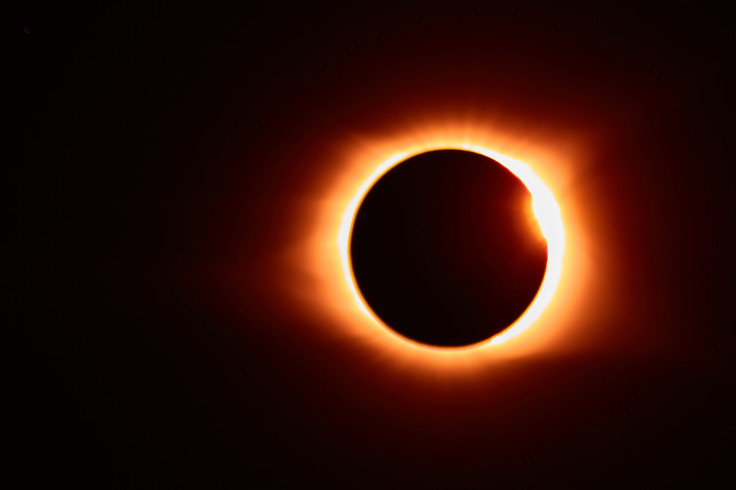
On April 8, the United States, Mexico, and Canada will be able to watch a total solar eclipse, offering millions the opportunity to experience the phenomenon as the sky turns dark for over four minutes. As the date approaches, NASA revealed the best locations to observe it in the United States.
According to the agency, the eclipse will begin over the South Pacific Ocean. Weather permitting, the first location in continental North America that will experience totality -referring to locations where individuals will experience complete blockage of the sun- is Mexico's Pacific coast at around 11:07 a.m. PDT.
The solar eclipse's path is set to enter the United States in Texas and travel through Oklahoma, Arkansas, Missouri, Illinois, Kentucky, Indiana, Ohio, Pennsylvania, New York, Vermont, New Hampshire, and Maine, NASA predicted.
Small parts of Tennessee and Michigan will also experience the total solar eclipse, its report added. In Canada, the eclipse will enter in Southern Ontario and continue through Quebec, New Brunswick, Prince Edward Island, and Cape Breton.
Finally, NASA expects it to exit continental North America on the Atlantic coast of Newfoundland, Canada, at 5:16 p.m. NDT.
A total solar eclipse happens when the sun, moon, and Earth align perfectly, resulting in sunlight being blocked. This phenomenon is why it seems to turn into night in the middle of the day.

The quality of observations will be influenced by weather conditions and the viewing location chosen by individuals during the eclipse. Approximately 32 million people reside in the path of this totality in the U.S.
People in North America who are outside the path of total solar eclipse will still be able to see a partial one.
The eclipse is anticipated to last four minutes and 28 seconds, nearly twice the duration of the one that shaded the skies in 2017. The United States will not witness another coast-to-coast total solar eclipse until 2045.
NASA warned that, barring brief totality, when the Moon completely blocks the Sun's bright face, "it is not safe to look directly at the Sun without specialized eye protection for solar viewing."
"Viewing any part of the bright Sun through a camera lens, binoculars, or a telescope without a special-purpose solar filter secured over the front of the optics will instantly cause severe eye injury," the agency added.
Top Locations for Viewing the Total Solar Eclipse, As NASA Reported
- Dallas, Texas. Partial begins at 12:23 p.m. CDT, totality begins at 1:40 p.m. CDT, maximum at 1:42 p.m. CDT, totality ends at 1:44 p.m. CDT, and partial ends at 3:02 p.m. DCT.
- Idabel, Oklahoma. Particle begins at 12:28 p.m. CDT, totality begins at 1:45 p.m. CDT, maximum at 1:47 p.m. CDT, totality ends at 1:49 p.m. CDT, and partial ends at 3:06 p.m. CDT.
- Little Rock, Arkansas. Partial begins at 12:33 p.m. CDT, totality begins at 1:51 p.m. CDT, maximum at 1:52 p.m. CDT, totality ends at 1:54 p.m. CDT, and partial ends at 3:11 p.m. CDT
- Poplar Bluff, Missouri. Partial begins at 12:39 p.m. CDT, totality begins at 1:56 p.m. CDT, maximum at 1:56 p.m. CDT, totality ends at 2:00 p.m. CDT, and partial ends at 3:15 p.m. CDT.
- Paducah, Kentucky. Partial begins at 12:42 p.m. CDT, totality begins at 2:00 p.m. CDT, maximum at 2:01 p.m. CDT, totality ends at 2:02 p.m. CDT, and partial ends at 3:18 p.m. CDT
- Carbondale, Illinois. Partial begins at 12:42 p.m. CDT, totality begins at 1:59 p.m. CDT, Maximum begins at 2:01 p.m. CDT, totality ends at 2:03 p.m. CDT, and partial ends at 3:18 p.m. CDT.
- Evansville, Indiana. Partial begins at 12:45 p.m. CDT, totality begins at 2:02 p.m. CDT, maximum at 2:04 p.m. CDT, totality ends at 2:05 p.m. CDT, and partial ends at 3:20 p.m. CDT.
- Cleveland, Ohio. Partial begins at 1:59 p.m. EDT, totality begins at 3:13 p.m. EDT, maximum at 3:15 p.m. EDT, totality ends at 3:17 p.m. EDT, and partial ends at 4:29 p.m. EDT.
- Erie, Pennsylvania. Partial begins at 2:02 p.m. EDT, totality begins at 3:16 p.m. EDT, maximum at 3:18 p.m. EDT, totality ends at 3:20 p.m. EDT, and partial ends at 4:30 p.m. EDT.
- Buffalo, New York. Partial begins at 2:04 p.m. EDT, totality begins at 3:18 p.m. EDT, maximum at 3:20 p.m. EDT, totality ends at 3:22 p.m. EDT, and partial ends at 4:32 p.m. EDT.
- Burlington, Vermont. Partial begins at 2:14 p.m. EDT, totality begins at 3:26 p.m. EDT, maximum at 3:27 p.m. EDT, totality ends at 3:29 p.m. EDT, and partial ends at 4:37 p.m. EDT.
- Lancaster, New Hampshire. Partial begins at 2:16 p.m. EDT, totality begins at 3:27 p.m. EDT, maximum at 3:29 p.m. EDT, totality ends at 3:30 p.m. EDT, and partial ends at 4:38 p.m. EDT.
- Caribou, Maine. Partial begins at 2:22 p.m. EDT, totality begins at 3:32 p.m. EDT, maximum at 3:33 p.m. EDT, totality ends at 3:34 p.m. EDT, and partial ends at 4:40 p.m. EDT.
© 2024 Latin Times. All rights reserved. Do not reproduce without permission.







